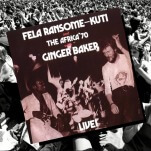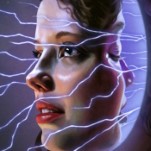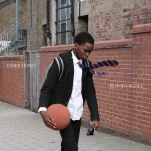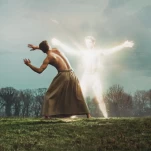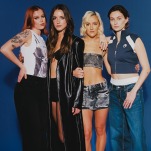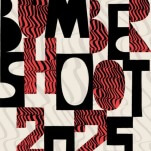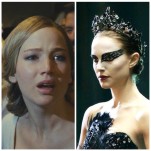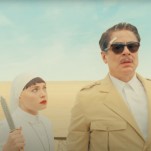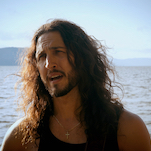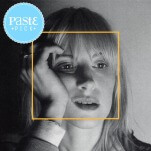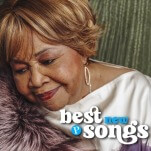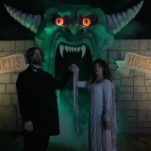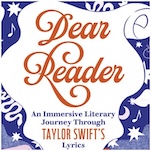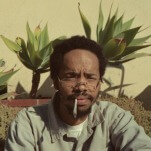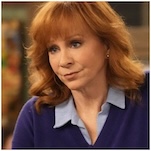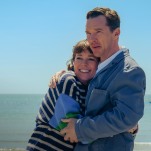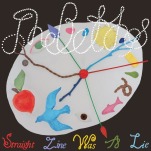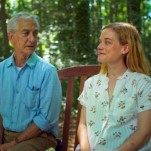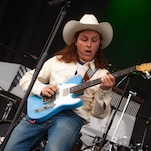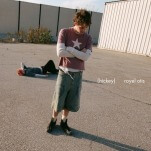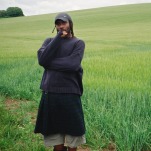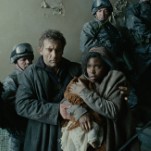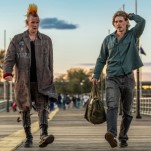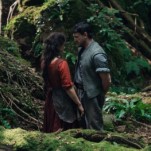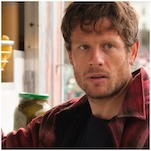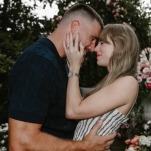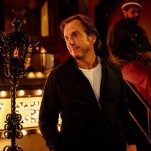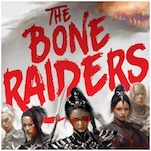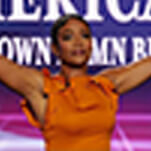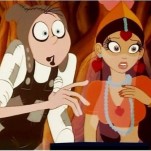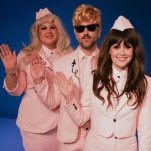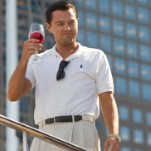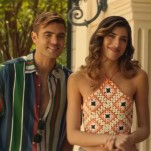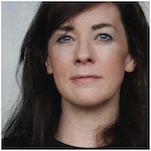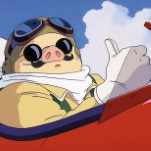24 Musicians Share Their Paintings
My favorite Father’s Day present was a set of paints and canvases from my kids. Sitting and painting together, I realized that it could be a much more relaxing and pressure-less creative outlet for me than writing—which was tied to my livelihood. Talking with musicians, it seems the same thing is often true for them—that there’s a definite tie between their music and visual art, but that they serve as different kinds of therapy for the soul.
So many of our favorite songwriters have found that there’s more than one way to scratch that creative itch. We asked 23 musicians—including Mindy Smith, Julianna Hatfield, Robyn Hitchcock, Joseph Arthur and Ani DiFranco—about their love of painting and to share some of their works.
1. Mindy Smith
New York native Mindy Smith moved to Nashville, where she won the Americana Award for Best New Artist in 2004 following her debut, One Moment More. She now has five studio albums, including the Christmas album My Holiday, under her belt. Her latest, Mindy Smith, was self-released in June.
When did you first start painting?
As early as 15 years, then on and off throughout my life.
Are you inspired by a particular painter or artistic movement?
I am a huge fan of Vincent Van Gogh. You can probably see that reflected in the way I use colors and ordinary objects. I do enjoy most methods and movements, but like most people certain pieces just move me more than others.
How does painting differ from music as a creative outlet for you?
I have always turned to the empty canvas when I find music a struggle emotionally, professionally and creatively. I am not however, always inspired regardless of the creative medium.
Where can we see your work in person?
In my office stacked one on top of the other.

By Mindy Smith

By Mindy Smith

By Mindy Smith
2. Kurt Wagner (Lambchop)
Since 1986, Kurt Wagner has fronted a large and ever-revolving cast of bandmates in the Nashville post-country group Lambchop, which released its 11th album on Merge Records this year.
When did you first start painting?
I started painting in the ’70s in art school. But I really didn’t focus on it until my last year of grad school around 1983. It just seemed like a more practical way of working once I left the cozy art-school bubble.
Are you inspired by a particular painter or artistic movement?
There are many inspiring artists that I look to like records in a record collection. Lately I’m drawn to the classics if only to study how they use paint and subject matter. There seems to be a level of proficiency reached in the 17th to 19th century that I find attractive these days.
How does painting differ from music as a creative outlet for you?
For myself, the main difference is the solitary aspect of its making. It’s not so collaborative as music is in its process. Other than that I find there to be more similarities than differences.
Where can we see your work in person?
My house. Stop on by.

By Kurt Wagner
3. Joseph Arthur
Ohio native and New York resident Joseph Arthur has released nine albums since 1997. His paintings are often incorporated in his album covers, leading to a Grammy nomination for Best Recording Package in 2000 for his EP Vacancy.
When did you first start painting?
I didn’t really start so much as never stop. My style is rough, so I figured I sucked at it. But when I was a kid, my mother told me that my drawings had a lot of personality, and her early encouragement went a long way. I never went to college but my sister did, and majored in art and that also had an influence. She’s a great painter.
Are you inspired by a particular painter or artistic movement?
My favorites are de Kooning, Basquiat, Pollock, Rauschenberg and Cy Twombly. I remember a friend of mine took me to a museum in Alabama when I lived in Atlanta in the early ’90s, and she said, “There’s this painter you need to check out.” I was pretty ignorant in matters of art and didn’t much look forward to making that trek to go see a painter’s work in a museum but when we walked in, my mind was blown. I couldn’t believe something could be so punk rock and yet refined in certain ways. It was a big Jean Michel Basquiat retrospective. That definitely had an impact.
How does painting differ from music as a creative outlet for you?
Well, for me it’s less pressure and even less precious, I think, because I made my livelihood with music long before I started making any money with the paints, so there’s always been a little more freedom for me in it. However, the process of painting is remarkably similar to the process of recording. Sometimes I think in terms of painting when I mix. For instance, both things use layers to degrade and clarify the expression. I’ve learned things in painting that I’ve applied to music and vice versa.
Where can we see your work in person?
This year I’ve had exhibitions in New York City, Paris, Los Angeles, Pennsylvania and Bielefeld, Germany. There are more to be announced soon, and in the meantime I always have an online gallery which can be viewed at museumofmodernarthur.com.
Also, I have original paintings, prints, posters, notecard sets, etc., all featuring my art, for sale on my online store: josepharthur.store-08.com/painting-of-the-month/.

Joseph Arthur’s paintings on guitar

Michael Stipe and Joseph Arthur at Arthur’s gallery showing
4. Juliana Hatfield
After fronting the Blake Babies from 1986 to 1991, Juliana Hatfield has released a dozen solo studio albums and two records with Some Girls (along with Freda Love and Heidi Gluck). She also published a memoir, When I Grow Up, in 2008.
When did you first start painting?
I painted a lot as a child and then at some point—around high -age—I put painting on the backburner to do music instead. I started coming back to painting about 10 years ago.
Are you inspired by a particular painter or artistic movement?
There are certain artists that I like a lot—Mark Tobey, Morris Louis, Andrew Masullo, Joan Mitchell, Egon Schiele, Jenny Saville, Tom Wesselmann. Kind of a random modern-ish (mostly 20th-century) assortment.
How does painting differ from music as a creative outlet for you?
Painting requires more concentration and more time. It’s quieter, obviously, and more solitary. Painting hurts my brain in a way that music theory does—I’m forced to think about what I’m trying to do, and why, and how. Physically, they feel different, too— playing music can be a cathartic release whereas when I’m painting, I’m usually in a state of heightened anxiety the whole time.
Where can we see your work in person?
You can’t see my work in person unless you come to my house. I hope to get something together eventually—a public showing—but I’m not ready yet.

By Juliana Hatfield

By Juliana Hatfield

By Juliana Hatfield
So many of our favorite songwriters have found that there’s more than one way to scratch that creative itch. We asked 23 musicians—including Mindy Smith, Julianna Hatfield, Robyn Hitchcock, Joseph Arthur and Ani DiFranco—about their love of painting and to share some of their works.
5. Mick Turner (The Dirty 3)
Australian guitarist Mick Turner has released music with a number of bands, most notably The Dirty Three, and collaborated with artists like Cat Power and Bonnie “Prince” Billy.
When did you first start painting?
When I was four, at Kindergarten. I did my first cover for a record—an early band “Sick things” 7-inch vinyl around 1982. I started exhibiting my artworks in 2003.
Are you inspired by a particular painter or artistic movement?
So many—I do like a lot of Australian painters. My style is mostly figurative like some of my favorites—Nolan, Blackman, Percival. I am also inspired muchly by folk art
How does painting differ from music as a creative outlet for you?
Since 2003 when I started spending much more of my time making visual art, from about 2% to 50%, the two have influenced each other more and more in terms of approach and mindset in a really satisfying and exciting way—new discoveries and paths in one translate to the other in a kind of lateral way. There’s nothing in painting that resembles playing live music but the approaches have many parallels. And the wonder of both lies in their emotive power.
Where can we see your work in person?
Join my mailing list at mickturner.com for notifications of exhibitions

By Mick Turner

By Mick Turner

By Mick Turner
6. Victoria Williams
Victoria Williams appeared on the cover of the very first issue of Paste in 2002 and was named one of the 100 Best Living Songwriters. The Louisiana native lives in Joshua Tree, Calif., and has released seven solo albums and seven with the Original Harmony Ridge Creekdippers. She’s also sang on albums of more than a dozen other artists, including Giant Sand, Joe Henry, Julie Miller and Vic Chesnutt.
When did you first start painting?
I’ve always painted in a primitive way. I’ve never taken painting classes. My mother was a painter, and I watched her and learned from that. My sister and brother and uncle are also artists. I got a job painting antique prints at the Pacific Design Center when I first came to California. It was watercolors that I used. Then I started doing drawings of mules—for too many years I painted mules. My sister, who is a great artist, has now done some mules and won a contest with them. She studied art and jewelry-making in college.
Are you inspired by a particular painter or artistic movement?
I always liked Marc Chagall, Picasso and Matisse.
How does painting differ from music as a creative outlet for you?
It’s a reprieve as you do it alone, and I find that working on both at the same time is helpful. With music, I like making many tapes, or DATs, but I don’t listened to them. So when I’m painting, I can put on the tapes and listen as I work.
Where can we see your work in person?
I recently sold one that was in my studio. It’s now at the studio of Micah Middaugh of Breathe Owl Breathe in Wisconsin. The painting on the back of Happy Come Home is one of mine.

By Victoria Williams

By Victoria Williams

By Victoria Williams
7. Will Johnson
Will Johnson of Austin, Texas, has released 16 albums as a solo artist and fronting the bands Centro-matic and South San Gabriel. He’s also been a member of the Undertow Orchestra, Baboon, Monsters of Folk, and most recently New Multitudes with Jay Farrar, Anders Parker and Yim Yames.
When did you first start painting?
On any regular basis, during the Spring of 2008. That’s when I started this run of baseball-related paintings.
Are you inspired by a particular painter or artistic movement?
Leon and Molly Bee Collins, Howard Finster, William Hawkins, Grandma Moses, Tim Kerr and Esther Pearl Watson are a few painters I like. More than anything, I’m inspired by an interesting story or piece of history. A subject that can hopefully teach the viewer and me something new. That’s what I try to focus on when I’m painting these players and stadiums.
How does painting differ from music as a creative outlet for you?
The painting is less of a physical, or animal thing to me. It’s a more solitary type of therapy, and it obviously unfolds in a quieter way. When I’m painting those old stadiums, I tend to take off into that world and time. If it starts to feel like a big daydream to me when I’m pushing the paint around, that’s when I enjoy it most.
Where can we see your work in person?
Team Love/Ravenhouse Gallery in New Paltz, N.Y. I have a show on display there until September 7th.

By Will Johnson

By Will Johnson
8. Tom Russell
Texas singer/songwriter Tom Russell has released a whopping 26 albums and three DVDs since 1976. In 2006, Joe Ely, Suzy Bogguss, Dave Alvin and Jerry Jeff Walker covered his songs for a Tom Russell tribute album called Wonded Heart of America.
When did you first start painting?
I started in 2003. Nine years ago.
Are you inspired by a particular painter or artistic movement?
My favorite painter is the Native American Fritz Scholder. An extreme colorist. He painted the West—in an edgy way.
How does painting differ from music as a creative outlet for you?
Painting is very similar to songwriting. The quick moments of mystical inspiration. The mystery of it all. You write, or paint, a good one—then turn around and slog away for weeks and months until the magic comes again. There’s something linking song and painting—you can hear songs over and over and get something new. Same with looking at a painting.
Where can we see your work in person?
I have a book of art out: Blue Horse/Red Desert: The Art of Tom Russell, published by Bangtail Press. It’s available from tomrussell.com and a Kindle version of the book essay, detailing my paint journey, is available on Kindle: Paint and Blood by Tom Russell at amazon.com/dp/B007I75WJC.
My paintings can also be viewed at tomrussell.com and also at the galleries Rainbow Man in Santa Fe and Yard Dog in Austin. See them at rainbowman.com and yarddog.com.

By Tom Russell

By Tom Russell

By Tom Russell
So many of our favorite songwriters have found that there’s more than one way to scratch that creative itch. We asked 23 musicians—including Mindy Smith, Julianna Hatfield, Robyn Hitchcock, Joseph Arthur and Ani DiFranco—about their love of painting and to share some of their works.
9. TOBACCO (Black Moth Super Rainbow)
Born Thomas Fec, TOBACCO is the songwriter for Pittsburgh experimental group Black Moth Super Rainbow. He’s also released two solo albums.
When did you first start creating collage art?
It started when I started making music in high school. I needed to have album covers for my music to seem real, so I’d cut up polaroids and weird family pictures so every tape I made had some kind of cover.
Are you inspired by a particular artist or artistic movement?
Really just inspired by all the big, bright grossout imagery that was so big when I was a kid.
How does making visual art differ from music as a creative outlet for you?
It doesn’t. I’m going for the same kind of thing with both.
Where can we see your work in person?
For now, the music and artwork goes hand in hand, so it’s all contained in my records. I can’t imagine one without the other, so I don’t see myself doing anything else with the visual pieces. For me, it’s the main thing that keeps physical media so important.

By TOBACCO

By TOBACCO
10. Trayer Tryon (Hundred Waters)
After releasing its self-titled debut, Trayer Tryon’s band Hundred Waters was just named one of Paste’s 10 Florida Bands You Should Listen To Now. The band just finished The Full Flex Express train tour of Canada with Skrillex, Diplo and Grimes.
When did you first start creating collage art?
My first painting was on a slab of concrete lifted from a sidewalk when I was 14.
Are you inspired by a particular artist or artistic movement?
The Austrian painter/architect Friedenreich Hundertwasser, whose name translates to Peace Kingdom Hundred Waters, where we found our name.
How does making visual art differ from music as a creative outlet for you?
At first very little; the music was just as wacko as the pictures. Since we’ve started the band a year ago, though, the music has become more aware of a listener, where the pictures still do whatever they want without question. That shift is a result of collaborating.
Where can we see your work in person?
Homes.

By Trayer Tryon

By Trayer Tryon
11. Hannah Hooper (Grouplove)
Hannah Hooper formed Los Angeles band Grouplove with Christian Zucconi in 2010. The band was named “The Best of What’s Next” by Paste last year prior to the debut full-length album Never Trust a Happy Song.
When did you first start painting?
Finger-painting in preschool, graffiti in high school, oil-painting in college, mixed media now.
Are you inspired by a particular painter or artistic movement?
I love Jenny Seville and Rembrandt and a plethora of other artists. I was also inspired by the grunge movement in music. Most of all, my brother Nate who pushed me to go to the dark side.
How does painting differ from music as a creative outlet for you?
Music is much more collaborative. It takes a while for someone to come see a painting in a studio, but when you’re playing music you’re sharing it with people immediately.
Where can we see your work in person?
Right now we’re on the road, so my art project is the band. If you come to our show you can see the backdrop that I painted, the album cover, which is a painting of mine, and sometimes I do live art on stage. Get weird. For older work I have some stuff on hannahhooper.com.

Nowhere by Hannah Hooper

Redondo Beach by Hannah Hooper

You Love Me by Hannah Hooper
12. Robyn Hitchcock
London-born Robyn Hitchcock has released two dozen albums, solo or fronting The Soft Boys, the Egyptians and the Venus 3 (Peter Buck, Scott McCaughey and Bill Rieflin). Jonathan Demme filmed Hitchcock in concert in 1998 for the film Storefront Hitchcock, and Hitchcock appears in Demme’s films The Manchurian Candidate and Rachel Getting Married.
When did you first start painting?
I’ve been drawing since I could speak, probably before the first Sputnik left earth. Painting since the early 1970s. I’m better with line than with color, but I keep trying.
Are you inspired by a particular painter or artistic movement?
Bosch, Breugel, Odilon Redon, Munch, Goya, DeChirico, Max Ernst, the people around the borders of surrealism, who are seen as ambassadors of the subconscious. That’s where I am with songs, ideally.
How does painting differ from music as a creative outlet for you?
Painting and drawing take longer, and unleash fewer emotions in me. Playing the guitar and singing digs a deeper well into my feelings, and out gushes a performance. When I draw and paint, I’m always in neutral. But it all comes from the same place: It’s what’s going on in the mind constantly, but we mostly aren’t encouraged to access it. My father Raymond painted, drew and wrote, so we were encouraged to prioritize whatever emerged from our heads. My younger sister, F.R. Hitchcock, has a book for children published on September 6th called SHRUNK! on Hot Key Books.
Where can we see your work in person?
Nowhere yet, I’m afraid, Josh. I’ve lost track of a few paintings; I need to do some more. But I reach for a guitar sooner than a paintbrush.

Faithful as a Mummy by Robyn Hitchcock

Glass Raymond Ship by Robyn Hitchcock

Prawn & Dr. Ferris by Robyn Hitchcock
So many of our favorite songwriters have found that there’s more than one way to scratch that creative itch. We asked 23 musicians—including Mindy Smith, Julianna Hatfield, Robyn Hitchcock, Joseph Arthur and Ani DiFranco—about their love of painting and to share some of their works.
13. Charlie Brand (Miniature Tigers)
Charlie Brand is the frontman for Brooklyn quartet Miniature Tigers, who’ve recently toured with Ben Folds and fun.
When did you first start painting?
I started painting two years ago. My favorite artist David Hockney had talked about this painting/drawing app on the iPhone called brushes. I went from never really expressing myself as a visual artist to creating hundreds of drawings and paintings. Within the last two months I started painting on canvas with acrylic. I seem to be moving backwards, in terms of technology. Next up is cave paintings.
Are you inspired by a particular painter or artistic movement?
David Hockney is my main man who lit the fire. His aesthetic speaks to me, and he’s tried so many different styles and mediums and excels in all. Right now I’m really into Matisse—I love how simple, yet complex his strokes are. I’m trying to apply that approach to how I make music lately.
How does painting differ from music as a creative outlet for you?
I’ve been working with music for most of my life and painting is more of a recent development. Right now is more of a discovery period. Just trying out different styles and approaches and even learning how to technically get across on canvass what I vision in my head. Where as ive come to a point with music that if I hear something in my head, I know with enough work I can get it out and have it sound how I imagined. Sometimes the most interesting things happen when you don’t know too much about what you’re doing.
Where can we see your work in person?
Nowhere at the moment. I post my iPhone paintings on my instagram (charliebrand) and sell prints. Some of my canvas paintings are hanging in my house. I would love to show in a gallery someday but have no clue how to tap into that world.

By Charlie Brand

By Charlie Brand

By Charlie Brand
14. Colin Frangicetto (Circa Survive)
Colin Frangicetto plays guitar for Philadelphia’s Circa Survive, who’s 2010 album Blue Sky Noise reached #11 on the Billboard charts. He also released a solo album last year under the name Psychic Babble.
When did you first start painting?
I drew a lot as a kid—mainly just stick figure battles and portraits of video game consoles at first. I was a graphic design major my first year of community college so that put me in all of the fine-art foundation classes where I first started actually using mediums other than pens and pencils. I dropped out after being told that, “I should reconsider my career path,” and pretty much stopped all visual arts and turned to music. I eventually finished with a film degree. About four years ago, I started painting as a way to pass time on tour, and it’s since grown into a full-time thing that I consider just as important to me as the band.
Are you inspired by a particular painter or artistic movement?
I think the same way a lot of musicians get into The Beatles as kids and then span out, a lot of artists first get into Picasso. For me its very much so that way. I adore him and most of his many contemporaries—Matisse, Duchamp, etc.—and then from there I found Warhol, Basquiat, Keith Harring etc. These days I have a huge pool of modern artists that inspire me. The conceptual art by ladies like Judy Pfaff and Janine Antoni, and then I love the Hi Fructose crowd like James Jean, Esao Andrews, Martin Wittfooth, Tara McPherson, etc.
How does painting differ from music as a creative outlet for you?
My process in both arenas has changed a lot of the years, and at this point they are quite different from each other. When I write music these days, it’s a much more intuitive thing. I usually don’t have any preconceived guidelines of what I want to write anymore. I just pick up a guitar or jump on the drums or sit at the keyboard and just go fishing into my subconscious. With my paintings, sculptures, etc., I do a pretty good amount of planning now. And I find that as I progress in visual art that planning is becoming more and more crucial to the end results. Sketches, color studies and even compositional layouts in Photoshop are all things I like to do now before starting the actual piece. As an outlet, painting feels more anonymous than music. Probably because I associate music so heavily with performing live. When I prepare for an art show, I have this long hermetic period of making the work and then when I hang/display the work in a gallery, no one is present. The show opens, and I get to be a fly on the wall while strangers and people I know stare at what I’ve made. So very different, but I find both are totally exhilarating.
Where can we see your work in person?
I recently had my first solo show in Philadelphia, but it came down about a month ago. I usually participate in at least two exhibitions a year, sometimes a lot more. People can stay in the loop of what I’m up to in the usual plethora of social media—colinfrangicetto.com, Facebook.com/ColinFrangicettoArt, @unconsciousart on Twitter and @colincirca on Instagram.

By Colin Frangicetto

By Colin Frangicetto

By Colin Frangicetto
15. Pieta Brown
Iowa City folk singer/songwriter Pieta Brown has released five full-length albums since her self-titled debut in 2002 and has performed with artists like Brandi Carlile, Amos Lee and Calexico.
When did you first start painting?
I’ve been messing around with watercolors off and on since I was a kid.
Are you inspired by a particular painter or artistic movement?
I love paintings of all kinds. Many eras and movements appeal to me. I spend more time looking at others’ paintings than I do making my own. As far as my own little watercolor paintings, an essay Henry Miller wrote called “The Angel Is My Watermark” about watercolor painting really inspired me. My father and my sisters (they all paint!) have inspired me too.
How does painting differ from music as a creative outlet for you?
Radically! I’m not a real painter. Just a musician/songwriter who does watercolors sometimes. I’m not driven by making watercolors in the same way at all, so it’s a creative place that is very open-ended. With music, I love to share it and collaborate and connect through music. I’m obsessed.
On the flip-side, watercolor painting for me is solitary and meditative, and I don’t get caught up in the end result. It’s a really fun creative process that helps me open up sometimes. And you use such different parts of yourself to make a painting. I think as any kind of artist/musician it’s helpful to access those “different parts” as much as you can. So I like to pass a watercolor painting on to a friend in a letter or something. But I’ve never imagined hanging one in a gallery.
But painting seems connected to music without a doubt. Some kind of energetic gesture or emotion—but that you can see instead of hear. And that, like music, is beyond words.
Where can we see your work in person?
Most of my watercolor paintings are used for writing notes or letters on—or stuck in a notebook. I’ve made a few prints of watercolors to sell (very cheaply!) at shows. I’ve received a very sweet response from people from those, and so I’ve started making some watercolors and printing song lyrics on them for fans of my music. You can check that out at pietabrown.com/news.cfm.

By Pieta Brown

By Pieta Brown

By Pieta Brown
16. Ani DiFranco
Buffalo, N.Y., singer/songwriter Ani DiFranco was a pioneer of independent recording, releasing 17 albums on her own label, Righteous Babe. In 2006, she received the Woman of Courage award from the National Organization for Women, and she won a Grammy for Best Packaging in 2004. Her latest album, ¿Which Side Are You On?, features Pete Seeger, The Neville Brothers, Anaïs Mitchell, Galactic and Rebirth Brass Band.
When did you first start painting?
I started painting as a child but developed a deeper interest as a teenager. At 16 I enrolled as a fine arts major at Buffalo State College and took a lot of drawing and painting classes.
Are you inspired by a particular painter or artistic movement?
I was very inspired by the abstract expressionist movement, with it’s emphasis on the emotional moment of creation instead of the calculation of a result or outcome.
How does painting differ from music as a creative outlet for you?
Both seem to be about turning off the left brain narrative of fear and self-consciousness and giving voice to the intuitive awareness of the right brain.
Where can we see your work in person?
Nowhere really, except for my house. I’ve been flirting with the idea of having a show some day but I need to develop what I’m doing some more first.

By Ani DiFranco

By Ani DiFranco

By Ani DiFranco
So many of our favorite songwriters have found that there’s more than one way to scratch that creative itch. We asked 23 musicians—including Mindy Smith, Julianna Hatfield, Robyn Hitchcock, Joseph Arthur and Ani DiFranco—about their love of painting and to share some of their works.
17. Rennie Sparks of Handsome Family
Rennie Sparks sings and plays banjo and bass in Handsome Family, alongside her husband Brett. The Chicago band has released nine albums since 1994, including Uncut magazine’s Country Album of the Year, Through the Trees in 1998.
When did you first start painting?
About five years ago, long after I started playing music.
Are you inspired by a particular painter or artistic movement?
I was actually inspired to start painting by dog food. I used to wander around gas station mini-marts while on tour looking for something to cheer me up. I noticed that whenever I looked at dog food cans, that inevitably have very eager looking dogs depicted on them, I would feel much happier. I started collecting dog food cans then, and I now have a collection of them from all over the world. One day at home I decided to try and paint a really happy dog face. After that I couldn’t stop trying to paint animal utopias.
How does painting differ from music as a creative outlet for you?
My paintings are always insanely joyful, but my music is usually somber and mournful. I can paint from an animal’s point of view, but can only play music from a human pov.
Where can we see your work in person?
Every painting I’ve done has been sold. I have a few portraits of my own dead pets hanging at my home in Albuquerque. You can see tons of sold work on my website, handsomefamily.com then follow link to paintings.

By Rennie Sparks

By Rennie Sparks

By Rennie Sparks
18. David Childers (Over Mountain Men)
Singer/guitarist David Childers plays in the North Carolina band Over Mountain Men with his son, Robert, and The Avett Brothers’ Bob Crawford. He’s also released 10 albums on his own and with The Modern Don Juans and The Mountain Holly Hellcats.
When did you first start painting?
I first started painting when I was 15. I quit in college and picked it up again at age 57 in 2008 when I became very ill from working 60 hours a week and riding in a van all over the East Coast to play gigs Fridays through Sundays. I used it to make myself stand up and move around for long periods since I could not exercise as I had regularly done. I’m now 61 and don’t think I’ll ever stop now.
Are you inspired by a particular painter or artistic movement?
Breughal, Van Gogh, Goya, Groz, and Otto Mueller, as well as much iconic religious art, and the Pre-Raphelites are inspirations that come to mind. My own son, Robert Childers, who also plays drums in our band, Over Mountain Men, is a big inspiration.
How does painting differ from music as a creative outlet for you?
Art is different from music in that I get to sleep in my own bed at night.
Where can we see your work in person?
You can see my art at Court Street Grill in Pomeroy, Ohio; High Rock Outfitters in Lexington, N.C.; and The Barking Spider Tavern in Cleveland, Ohio.

By David Childers

By David Childers

By David Childers
19. Jan Krist
Detroit’s singer/songwriter Jan Krist has released seven full-length albums, for which she’s won four Detroit Metro music awards. Her son Ian plays vibraphone for Blind Pilot and her daughter Amon was in the band Velour 100.
When did you first start painting?
I was an artist before I was a musician so, when I was in my teens. I won a Gold Medal Scholastic Art Award and a Gold Key when I was at Berkley High School, and I won the senior art award when I graduated. I went to Olivet College in 1972 as an art major and then dropped out. I had a baby pretty quickly, and I started finding it easier to work on my music when the kids were young. I started singing in clubs, writing more songs, etc. Then in in 1995, the year that I did Curious with Newton Carter and Jim Dickenson, I got a new set of paints from my husband Alan Finkbeiner. I took a few classes. I started taking my paints with me on the road. Instead of taking photos I painted. I took a few more classes. Then four years ago, I started working on my BFA in earnest and am a junior in the BFA program at Indiana, Purdue University Fort Wayne. I have won scholarships (which help significantly with tuition) based on my work the past two years, and so I’m full time now.
Are you inspired by a particular painter or artistic movement?
Yes. It all inspires me. Hopper, The Wyeths (all of them), Georgia O’Keefe, Mary Cassatt, mostly realism though I particularly enjoy painters whose work is more than “look see”. Winslow Homer’s “The Veteran in a New Field” is a painting I particularly admire. Beautifully painted, thick with meaning because of the words that accompany the image. It’s brilliant.
How does painting differ from music as a creative outlet for you?
The difference may just be the solitary nature of art, the physical act of painting, the singular focus and the physical motion involved. It’s just you and the process, like a meditation.
Where can we see your work in person?
I’m not showing my work right now. I’m working toward my senior show and building a body of work for that. I’ve sold or given away most of my work to date; now I have to build a collection. My plan is to finish the BFA and move on to an MFA. I’m working on a series called ”temporal,” using watercolor on cotton. I discovered that when you apply the watercolor to the cotton and hold it up to the light it becomes incredibly luminous, like a stained glass window. The canvases are hung from a clothesline within a free standing frame. There’s a lot to it, but all of the parts are meant to be temporary, even though there’s a tremendous amount of work in them. I’m also working in clay for part of the series.
20. Jackie Greene
As well as releasing six solo albums on labels like Verve Forecast, Jackie Greene is currently in two other bands—Trigger Happy with Joan Osborne and WRG with the Grateful Dead’s Bob Weir and the Black Crowes’ Chris Robinson.
When did you first start painting?
I’ve been drawing since I was a kid. It started with comic books. I used to make up my own comic books and put them together with my friends.
Are you inspired by a particular painter or artistic movement?
For me, it’s Picasso. I admire many, many painters, but the sheer volume of his work is staggering. It seems like he tried everything. The versatility is what draws me in. From sculpture to printmaking. He was a genius, for certain.
How does painting differ from music as a creative outlet for you?
Actually, it doesn’t. To me, creating music and making a painting are very, very similar. For me, it all comes from the same place. I suppose I make more of a mess when I paint, though.
Where can we see your work in person?
At jackiegreeneart.com Some selected pieces will be in the Agora Gallery in NYC starting in 2013, I believe.

Life Cycle by Jackie Greene
So many of our favorite songwriters have found that there’s more than one way to scratch that creative itch. We asked 23 musicians—including Mindy Smith, Julianna Hatfield, Robyn Hitchcock, Joseph Arthur and Ani DiFranco—about their love of painting and to share some of their works.
21. Wade Schuman (Hazmat Modine)
Wade Schuman is the lead singer for New York blues/fusion band Hazmat Modine, whose latest album Cicada features guest appearances by Natalie Merchant and the Kronos Quartet and won the Charles Cros Grand Prize in France for best Blues record in 2011.
When did you first start painting?
I’ve made art my whole life; it was in the fabric of my family. I’m a third-generation artist and art teacher. My great-grandfather, great-aunt and mother were all artists and art teachers. I started painting in oil in high school, however. Before that it was mostly drawing, cartooning, sculpture, whatever I could make. I went to school at RISD and PAFA.
Are you inspired by a particular painter or artistic movement?
I’m inspired by many things both old and new, “artistic” and otherwise, but I very specifically studied what people call “old master” techniques—European painting of the 16th and 17th centuries. I also love American art in the form of the early modernists and the great cartoonists of the 1920s through to the 1960s. Say, George Herriman of Krazy Kat fame and Robert Crumb, and a lot of the underground cartoonists—I think they were fearless.
How does painting differ from music as a creative outlet for you?
Music is more raw for me and comes from a very different place. It’s more immediate and intuitive. I’m self-taught as a musician and rely on my gut and my instinct. Performance is a form of communal art and exists in the here and now and is cathartic in nature. My painting is a solitary pursuit that involves a more intellectual or contemplative relationship to creativity and to history. They both involve feeling, but one is more private and the other more communal—it’s sort of a yin/yang relationship.
People always ask me if I’m a painter first or a musician first, and I always say, “Why do I have to make a choice? Why do you have to ask?” By some predilection that’s very confusing to people. The idea that you can seriously be professional in more then one thing and be good at it—we tend to think you have to be an amateur in at least one of the things you do. We like specialists!
Where can we see your work in person?
I show at Forum Gallery in New York City: www.forumgallery.com. I teach Painting, Drawing and Art History at The New York Academy of Art in New York City where I chair the Painting Department.

Bird and Egg by Wade Schuman

Insect by Wade Schuman

Conversation by Wade Schuman
22. Matt Gangi (Gangi)
Matt Gangi is the singer for Los Angeles psych duo Gangi, whose second album gesture is out Oct. 2.
When did you first start painting?
Apparently I’ve been painting since I learned how to crawl out of the crib. My mom told me that I must have seen where she kept her acrylics. One day, I apparently had crawled out of the crib, pushed a chair over and climbed up to where she kept her paints and grabbed them… and then I proceeded to use them as finger paints and finger painted the floor in a spectral array. She was pretty bummed when she found me. After that, my brother used to set me up in front of a window and have me paint different things. I have a vivid memory of him having me paint Medusa. But I was afraid to look at her face even as I was painting her after he had told me the Medusa tale.
Are you inspired by a particular painter or artistic movement?
From the past, post-war, I’m interested in Fluxus and the Situationist International. Eric [Chramosta] had turned me onto the United States of America, the band, and I had sampled a piece of one of Joseph Byrd’s compositions in one song. Joseph is one of the founders of Fluxus and one of the pioneers of electronic sound in rock music. He wrote me that he liked my music, but that I needed to credit him for the use of his music in my composition. We originally didn’t give him credit on it as we were afraid of being sued. When Joseph first contacted me, I didn’t believe it was really him as he wrote me a message from a newly created profile on Myspace (when people still used that interface). I thought it was someone else pretending to be Joseph Byrd. So originally I wrote back to one of my heroes telling him that he wasn’t the real Joseph Byrd and essentially telling him to go to hell. I was convinced that it was him once he sent an email back from his College of the Redwoods email address where he’s currently teaching some classes in music composition. It blew my mind and I responded by apologizing and saying that I might not have even sampled him or been interested in appropriation/pastiche if it weren’t for the Fluxus movement, and then, of course, gave him credit, and then he gave me his blessings.
I’m also interested in a lot of experimental literature movements that use visual poetry like a lot of the writers in New York right now—Lytle Shaw, Rob Fitterman and Brian Kim Stefans who just semi-recently moved to Los Angeles. Brian’s digital poetry is really interesting conceptually and visually. He’s also trying to get a little collective happening of friends and friends of friends in Los Angeles to work on pieces and projects together. A group of us recently made some pieces for a compilation that he put together called the Los Angeles Telephone Book, which you can download for free at mediafire.com/?gxqkj7fw39lndkn. I cut up pages of strange ads that were in the Los Angeles County Burbank/Glendale Yellow Pages/Telephone book to assemble a piece and even used the front cover of the phone book. Andrew Maxwell is an important part of that group who facilitates readings and performances at the Poetic Research Bureau and who also turned me onto some music/art groups like Caroliner Rainbow.
How does painting differ from music as a creative outlet for you?
I studied film in school and I think that film and music are very similar in that they’re both temporal or time-based mediums. Contrastingly, a painting (unlike music or film) isn’t bringing you along a time-based trip. It’s a static object rather than a moving piece. I really like that a painting isn’t as narrative-based as some popular music and most popular film. Sometimes I’ll watch a movie and get really lost in the narrative as I’m still thinking about a particular image even though the progression of the film has moved forward. In a painting you can think about it or be with the image as long as you want without it running to the next sequence as a musical piece does or as a film does. Hopefully in our music, we make enough space so that there is time for the listener to run with her/his own different ideas. As the reception of painting and the reception of music is very different in this way in respect to time, it also changes how it is made. The process can be kind of similar too though. Eric Chramosta and I have been sometimes working in a very cut-and-paste kind of way, usually even cutting and pasting our own musical ideas, and it’s similar in painting when you come back to a piece you’re working on. I had made one collage with children walking on a piece of equipment in the sky, and Nicole Zoppi had found an image of Nancy Reagan holding her hands up to them, which she added to complete the image and make it funny and interesting. I sometimes paint things like op amp schematics for circuits that I build to make and record music with, which is a similar kind of borrowing to create a whole picture.
Where can we see your work in person?
Right now, our self-release label and art collective, the Office of Analogue and Digital (O O A A D) is looking for a space to have an art show. We have a group of friends making interesting work, some of whom are also musicians! If anyone knows of a cool space and would want to host and collaborate with us on a show, please email [email protected]. Thanks for the platform!

By Matt Gangi
23. Natalia Zuckerman
New York singer/songwriter Natalia Zuckerman has released five albums. As accomplished an artist as she is a musician, she included original paintings in some preordered copies of her latest, Gas Station Roses.
When did you first start painting?
I was terribly dyslexic as a kid and couldn’t read (books or music) until a pretty late age. I learned to play music by ear, and I learned to write by copying the images I saw. Over and over and over again. The capital letters B and E, the numbers 3 and 4, they became almost abstract shapes, my pencil tracing the lines that were written out for me until I could replicate them on my own.
We had an assignment in 4th or 5th grade that had something to do with Egyptians, and I ended up copying a wall painting from a Pharaoh’s tomb. I copied exactly the image that I saw, taking what I’d learned from my reading and writing lessons (brain re-organizing!) and applying it to these forms—bodies, clothes, instruments, colors, lines and shadow took shape on the page. It was my first painting and I still have it- framed and in a storage box…somewhere!
Are you inspired by a particular painter or artistic movement?
My grandmother (my mom’s mom) was a painter and ceramist. I loved visiting my grandparents and playing with clay in the basement of their house. In high school, I loved painters like John Singer Sargent, Andrew Wyeth and of course I had a poster of a Dali painting and an Escher print in my room. Later, I discovered Jenny Saville and her exploration of the female form blew my mind. But it wasn’t until college that I discovered what moves me the most—a guest speaker came to my art history class to talk about the Chicano Mural Art Movement. I learned about Los Tres Grandes—Rivera, Orozco and Siqueiros and their influence on the mural-art movement in California, Chicago, Philadelphia and New York. I started studying the women muralists in California like Judith Baca, Susan Cervantes and others. I read and looked at everything I could find and decided I’d move to San Francisco after college to paint murals. And I did! It took me a while though—I was a mural tour guide first through Precita Eyes and then started volunteering on community art projects before starting my own mural company, Off The Wall. It’s the community art process that still excites and inspires me most—its ability to tell a story, to ignite activism and to bring together groups of people to create long-lasting, meaningful and beautiful works of art.
How does painting differ from music as a creative outlet for you?
I’m actually beginning to see these two disciplines as coming from the same place. My friend Andy Friedman (musician and incredible illustrator/cartoonist for publications like The New Yorker and Time) once described creativity to me by saying that it’s like water coming out of a hole. If you put your finger in it, you can manipulate it and make it come out sideways—slower, faster, up, down. But it’s always the same water. In other words, whether “it” is coming out as a mural, a painting on canvas, a song, or a piece of wooden jewelry, it’s coming from the same place, the same well. Both require a lot of work, practice, attention. When I’ve spent too long a stretch on music, my brushes start screaming at me and vice versa- when I’m spending too much time in my studio, my guitar looks so lonely. And mad! So they’re not that different—needy, rewarding, expansive, maddening and freeing all at the same time.
Where can we see your work in person?
My most recent murals are in restaurants in Brooklyn—Villa Pancho Taqueria at 1047 Bedford Avenue; Back 9 Grill at 635 Vanderbilt Ave.; Zaytoons at 472 Myrtle Avenue. Other murals: People’s History of Telegraph Avenue (Telegraph and Haste, Berkeley, Calif.); Planet Rainbow (Rainbow School, Oakland, Calif.), Alice on the Wall (Chambers Street, New York); Yellow Metrobus and Una Pequena Historia de Nuestros Mundos (Havana, Cuba), Tiny Teeth (Phoenix, AZ). I’m also designing necklaces for Bergevin-Lane Vineyards in Walla Walla, Wash., and they’re available in the winery and storefront. They’re hand-painted miniatures on reclaimed guitar wood. I’m also currently at work on commissioned paintings based on song lyrics.

Lulu by Natalia Zuckerman

Bang Crash by Natalia Zuckerman
24. Tyson Vogel (Two Gallants)
Singer/drummer Tyson Vogel has been making music with his friend Adam Stephens since the pair were 12 years old. A dozen years later, they signed to Saddle Creek records as Two Gallants. Next week the duo will release their fourth album The Bloom and the Blight on ATO Records. The vinyl version includes a bonus 7-inch with a cover of Abner Jay’s “I’m So Depressed” on Side A and an etched-in design by Vogel on the flip side.
When did you first start painting?
Growing up I constantly felt blindly drawn to the arts, I had an easel when I was 5 or 6, painting in watercolor… but around 12-13 years of age, I realized that painting/drawing was a form that was a real outlet for me, by 15 I was taking community painting classes at the Art Institute in San Francisco, while taking AP art in my high school. By 18 I was enrolled in college level art school, with a focus on painting.
Are you inspired by a particular painter or artistic movement?My first inclinations when delving into painting and the movements that inspired certain periods, was a real interest in abstract expressionism/cubism/surrealism… the way the paint
and methods of application were used to delve into the process of excavating and expressing emotion through color and stroke, while also experimenting with the physicality of the materials one was working with to affect the most basic senses. But around 16 years of age I stumbled upon Odd Nerdrum and Jean Michel Basquiat… and still to this day, though they represent very opposite sides of the painting spectrum, find these two individuals and their work inspirational.
How does painting differ from music as a creative outlet for you?
I find that painting is intrinsically linked to my process of creating music, it is another form that explores the same root music does, but in a whole different fashion and manner. I find music to be a very visual medium, though it’s physicality is formless, and I find painting to be very musical, though it is silent, and I feel there is a great silent marriage in both forms for me… one helps to explore and clarify the other.
Where can we see your work in person?
I have yet to feel ready, or comfortable, to show this side of my interests in a public setting… but more than that, I haven’t looked into showing. I recently was asked to do an artist residency at a strong gallery in San Francisco called EverGold Gallery, where I had the opportunity to do a piece on a 7 × 11 ft wall and have it displayed during the opening of my installation. Apart from that, at the moment, one can steal into my apartment or through my art journals—that I bring on tour with a set of ink and gouche—to keep that silent side of my existence nurtured, and view the horror.

By Tyson Vogel

By Tyson Vogel

By Tyson Vogel
GET PASTE RIGHT IN YOUR INBOX
The best music, movies, TV, books, comedy and more.
-

-

-

-

-

-

-

-

-

-

-

-

-

-

-

-

-

-

-

-

-

-

-

-

-

-

-

-

-

-

-

-

-

-

-

-

-

-

-

-







